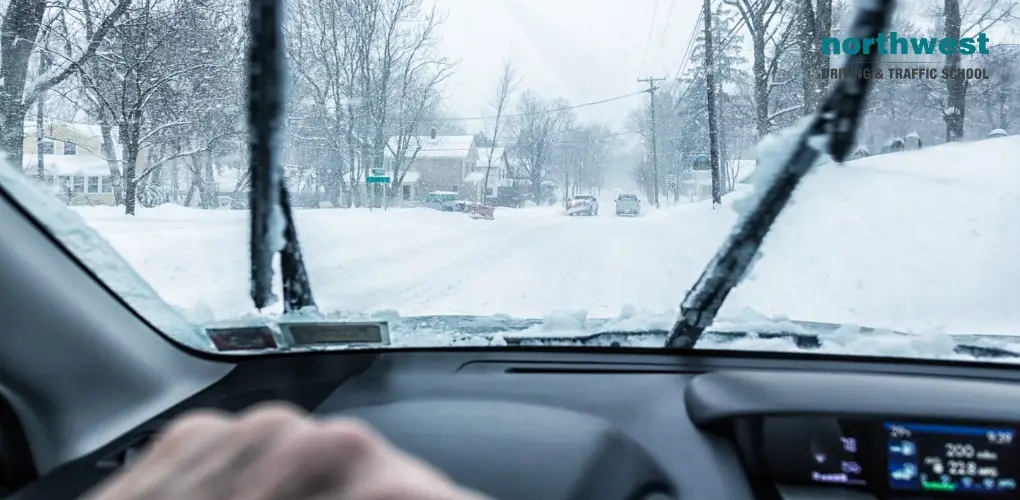- Driving School
How To Drive Safely In The Snow

Snow is one of the most challenging driving conditions that most drivers face on a regular basis. A heavy snowfall combines slippery road conditions, low visibility, and a particulate buildup on your car that make both the other issues that much worse.
From 2013 to 2017, there were 2,718 fatalities that resulted from winter weather-related car crashes, as caused by snow, sleet or ice on the U.S, with the states Michigan, Pennsylvania, New York, Ohio, and Illinois, accounting for 36% of winter weather-related driving fatalities.
To help you stay safe this winter, especially if you live in one of those states, we’ve put together some tips for driving safely in the snow so, even if you’ve only recently passed your test, you’ll know how to brave the winter weather.
Table of Contents
Know When Not To Drive
It’s very difficult to have a car accident when you are sat at home in front of the TV. One of the best ways of avoiding hazardous road conditions is to actually avoid them, so if the snow is coming down hard ask yourself “do I need to leave the house?”
Plan your car journies around the weather forecasts, consider other modes of transport such a walking or underground public transport and, if you don’t really need to drive, make yourself a hot chocolate and stay off the roads.
Plan Your Journey
Proper preparation is the best way to stay safe on most car journeys and having a plan is even more important during snowy weather. If you do need to drive, your route beforehand, stick to the main roads as they will almost certainly be better gritted and cleared, and keep an eye on local traffic updates to avoid accidents and road closures.
Avoiding Black Ice
Black ice is a thin layer of ice on the road surface that’s usually transparent. Because it is transparent, it’s very difficult for drivers to see and so represents one of the greatest hazards to winter drivers.
Black ice is caused by rain or melted snow freezing on a road surface. You’re are most likely to find it in places where water can settle and there isn’t much sun. These include tree-lined routes tunnels, bridges, overpasses, and “road-beneath” overpasses.
If you are driving in icy conditions, take the following precautions:
- Stay slow! Things can go wrong very quickly in icy and slippery conditions and you’ll need extra time to react, so keep your speed as low as possible.
- Avoid sudden braking, quick acceleration or aggressive steering as these are more likely to make you lose control. Reduce your speed smoothly and use your brakes gently.
- If you do hit black ice, stay calm. Avoid sudden or aggressive maneuvers and don’t hit the brakes immediately as this will cause you to skid. Lift your foot off the accelerator fully and try to keep the steering straight. This will hopefully allow your car to pass over the ice without skidding or spinning out.
Tips For Driving In Snow
- Go easy on the throttle. Harsh acceleration is much more likely to cause wheel spin, so keep a light foot on the gas pedal.
- When you pull away, do it in second gear and try to ease your foot off the clutch gently to avoid wheel spin.
- Slamming on the breaks can cause you to lose control, so use engine braking through the gears. Remember to touch the brake pedal lightly so the cars behind you can see your brake lights.
- Stay in a low gear and try to avoid braking as much as possible. Leave as much room as you can to the car in front.
- Remember, in bad weather conditions, a car’s stopping distance will be longer. Braking distances can be doubled in wet conditions and increased by at least 10 times when there is snow or ice on the road.
- If you drive an automatic, check your manual to see if your car has a setting for icy conditions. Some cars will have a “winter” setting that helps provide better traction on slippery roads.
- If there is heavy snow, turn your headlights on. Daytime running lights won’t be enough, and they don’t provide any lighting at the back of your car. You’ll need to make sure you can see ahead, and the cars behind you know you’re there.
Learn To Drive In Nevada
The Northwest Driving School provides driving and traffic classes in Las Vegas. All of our driving instructors have passed background checks, each automobile is DMV safety-approved and every member of the Northwest family is committed to providing excellent drivers ed and behind the wheel instruction.
Call us at (702) 212-5667 to start your driving adventure with one of our expert instructors.


